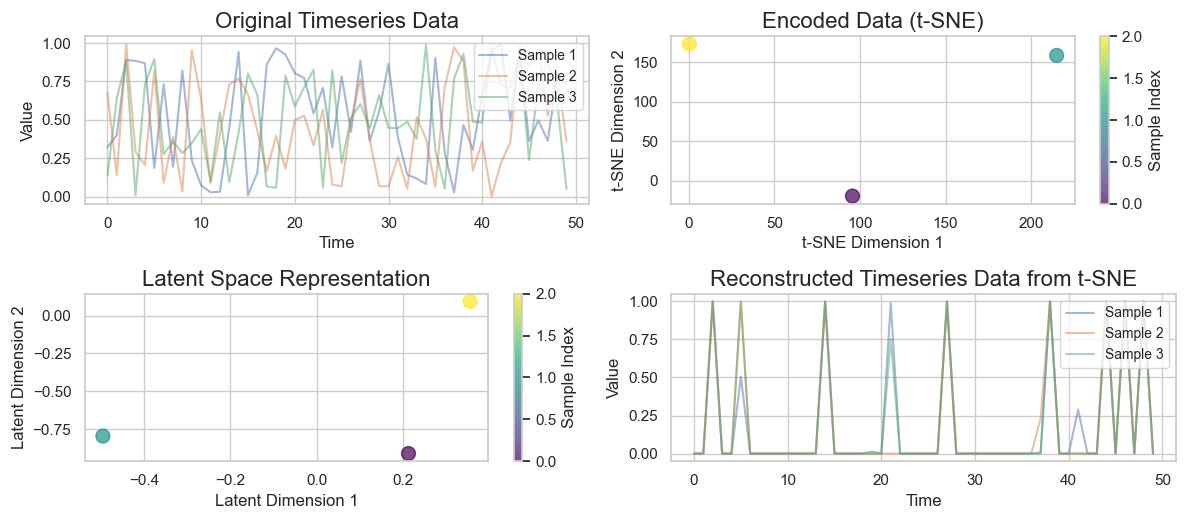Variational Autoencoders for Timeseries Data Generation
An Innovative Approach to Generating Synthetic Timeseries Data through VAEs
Variational Autoencoders (VAEs) have emerged as a powerful tool in machine learning, particularly for generating new data from learned representations. In this post, we will explore a practical implementation of a VAE designed specifically for generating synthetic timeseries data. By the end, you will have a good understanding of the code and how it works.
What is a Variational Autoencoder?
A Variational Autoencoder is a type of generative model that learns to represent data in a lower-dimensional latent space. The VAE consists of two main components: the encoder, which compresses the input data into a latent representation, and the decoder, which reconstructs the original data from this representation. Unlike traditional autoencoders, VAEs assume that the latent space follows a probability distribution, usually Gaussian. This allows VAEs to generate new data by sampling from this distribution, making them particularly useful for tasks like anomaly detection, data generation, and unsupervised learning.

Key Features of the VAE:
Generative Capability: VAEs can generate new data samples by sampling from the latent space.
Latent Space Representation: The structure of the latent space reveals patterns in the data.
Why Use VAEs for Time Series?
Time series data—such as stock prices, weather patterns, or even EEG signals—often requires specialized methods due to its temporal nature. By leveraging VAEs, we can capture the underlying patterns of time series data in a compressed form. This can help us visualize the data more effectively, reduce dimensionality, and even generate new synthetic time series that resemble the original dataset.
Our Approach
In this implementation, we generate synthetic time series data, train a VAE to learn latent representations, and use t-SNE (t-distributed Stochastic Neighbor Embedding) to visualize the lower-dimensional embeddings. We’ll also reconstruct the data to see how well the VAE performs in recreating the original time series.
Explanation of Key Components
Data Generation: The
generate_timeseries_datafunction creates synthetic timeseries data for training the VAE. It generates random values within a specified shape.
def generate_timeseries_data(num_samples, num_timesteps):
"""
Generate synthetic timeseries data.
Parameters:
num_samples (int): Number of samples in the dataset.
num_timesteps (int): Number of timesteps in each sample.
Returns:
np.ndarray: Generated timeseries data with shape (num_samples, num_timesteps).
"""
return np.random.rand(num_samples, num_timesteps)
VAE Class: The
VAEclass encapsulates the architecture of the autoencoder:
Encoder: Maps the input data to a latent space using a dense layer.
Decoder: Reconstructs the input data from the latent representation.
class VAE(models.Model): """ Variational Autoencoder (VAE) model. Parameters: input_dim (int): Dimension of input timeseries data. latent_dim (int): Dimension of the latent space. """ def __init__(self, input_dim, latent_dim): super(VAE, self).__init__() self.input_dim = input_dim self.latent_dim = latent_dim self.encoder = self.build_encoder() self.decoder = self.build_decoder() def build_encoder(self): encoder_input = layers.Input(shape=(self.input_dim,)) x = layers.Dense(128, activation='relu')(encoder_input) z_mean = layers.Dense(self.latent_dim)(x) z_log_var = layers.Dense(self.latent_dim)(x) encoder_output = layers.Lambda(self.sample_z, output_shape=(self.latent_dim,))([z_mean, z_log_var]) return models.Model(encoder_input, [z_mean, z_log_var, encoder_output]) # Ensure to return all three outputs def build_decoder(self): decoder_input = layers.Input(shape=(self.latent_dim,)) x = layers.Dense(128, activation='relu')(decoder_input) decoder_output = layers.Dense(self.input_dim, activation='sigmoid')(x) return models.Model(decoder_input, decoder_output) def sample_z(self, args): z_mean, z_log_var = args batch_size = tf.shape(z_mean)[0] latent_dim = tf.shape(z_mean)[1] epsilon = tf.random.normal(shape=(batch_size, latent_dim), mean=0., stddev=1.0) return z_mean + tf.exp(0.5 * z_log_var) * epsilon def call(self, inputs): z_mean, z_log_var, z = self.encoder(inputs) # Correctly unpack all three outputs reconstructions = self.decoder(z) return reconstructions, z_mean, z_log_varLoss Function: The
vae_lossfunction combines reconstruction loss and Kullback-Leibler (KL) divergence to ensure the model learns a smooth latent space.
def vae_loss(y_true, y_pred, z_mean, z_log_var): """ Define the loss function for the VAE model. Parameters: y_true (tf.Tensor): Ground truth values. y_pred (tf.Tensor): Predicted values (reconstructed data). z_mean (tf.Tensor): Mean of the latent variable. z_log_var (tf.Tensor): Log variance of the latent variable. Returns: tf.Tensor: Total loss (reconstruction loss + KL divergence). """ mse_loss = tf.keras.losses.MeanSquaredError() recon_loss = mse_loss(y_true, y_pred) kl_loss = -0.5 * tf.reduce_mean(1 + z_log_var - tf.square(z_mean) - tf.exp(z_log_var)) return recon_loss + kl_lossTraining Loop: The
mainfunction handles the data normalization and training process of the VAE over specified epochs.
def main(num_samples, num_timesteps, latent_dim, epochs, batch_size): # Generate synthetic timeseries data data = generate_timeseries_data(num_samples, num_timesteps) # Normalize the data data_mean = data.mean() data_std = data.std() data_normalized = (data - data_mean) / data_std # Create VAE model vae = VAE(num_timesteps, latent_dim) vae.compile(optimizer='adam') # Remove the custom loss from here # Custom training loop for epoch in range(epochs): with tf.GradientTape() as tape: reconstructions, z_mean, z_log_var = vae(data_normalized) loss = vae_loss(data_normalized, reconstructions, z_mean, z_log_var) # Pass the outputs to the loss function grads = tape.gradient(loss, vae.trainable_variables) vae.optimizer.apply_gradients(zip(grads, vae.trainable_variables)) print(f'Epoch {epoch + 1}, Loss: {loss.numpy()}') # Print the loss for each epoch # Reduce dimensionality of timeseries using the trained encoder z_mean, z_log_var, encoded_data = vae.encoder.predict(data_normalized)5. Visualizations: After training, we visualize the original timeseries data, the encoded data in the latent space, and the reconstructed data.
The code generates several visualizations:
Original Timeseries Data: Displays the input data.
Encoded Data (t-SNE): Shows the latent representation reduced to 2D.
Latent Space Representation: Visualizes the encoded data in the latent space.
Reconstructed Timeseries Data: Illustrates how well the model can reconstruct the original data.
Conclusion
VAEs are a powerful way to understand and generate timeseries data, providing insights into the underlying patterns within the data. By utilizing TensorFlow and Keras, this implementation offers a flexible and robust framework for experimentation.
For the complete code and further exploration, check out the GitHub repository.


